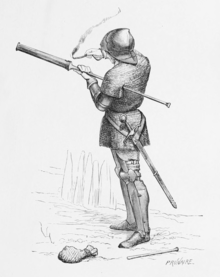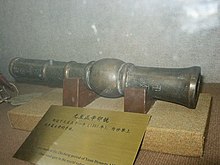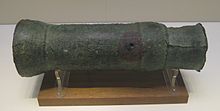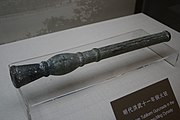Hand cannon

| Part of a series on |
| Cannons |
|---|
 |
Thehand cannon(simplified Chinese:Súng etpigôn;traditional Chinese:Súng etpigôn;pinyin:huǒchòngorTay súng;Tay súng;shǒuchòng), also known as thegonneorhandgonne,is the first truefirearmand the successor of thefire lance.[1]It is the oldest type ofsmall armsas well as the most mechanically simple form of metal barrel firearms. Unlikematchlockfirearms it requires direct manual externalignitionthrough atouch holewithout any form of firing mechanism. It may also be considered a forerunner of thehandgun.The hand cannon was widely used inChinafrom the 13th century onward and later throughoutEurasiain the 14th century. In 15th centuryEurope,the hand cannon evolved to become the matchlockarquebus,which became the firstfirearmto have atrigger.[2]
History
[edit]

China
[edit]
The earliest artistic depiction of what might be a hand cannon—a rock sculpture found among theDazu Rock Carvings—is dated to 1128, much earlier than any recorded or precisely dated archaeological samples, so it is possible that the concept of a cannon-like firearm has existed since the 12th century.[3]This has been challenged by others such as Liu Xu, Cheng Dong, and Benjamin Avichai Katz Sinvany. According to Liu, the weight of the cannon would have been too much for one person to hold, especially with just one arm, and points out that fire lances were being used a decade later at theSiege of De'an.Cheng Dong believes that the figure depicted is actually a wind spirit letting air out of a bag rather than a cannon emitting a blast. Stephen Haw also considered the possibility that the item in question was a bag of air but concludes that it is a cannon because it was grouped with other weapon-wielding sculptures. Sinvany concurred with the wind bag interpretation and that the cannonball indentation was added later on.[4]
The first cannons were likely an evolution of thefire lance.In 1259 a type of "fire-emitting lance" (tūhuǒqiãngĐột súng kíp ) made an appearance. According to theHistory of Song:"It is made from a large bamboo tube, and inside is stuffed a pellet wad (zǐkēTử khoa ). Once the fire goes off it completely spews the rear pellet wad forth, and the sound is like a bomb that can be heard for five hundred or more paces. "[5][6][7][8][9]The pellet wad mentioned is possibly the first true bullet in recorded history depending on how bullet is defined, as it did occlude the barrel, unlike previous co-viatives (non-occluding shrapnel) used in the fire lance.[5]Fire lances transformed from the "bamboo- (or wood- or paper-) barreled firearm to the metal-barreled firearm"[5]to better withstand the explosive pressure of gunpowder. From there it branched off into several different gunpowder weapons known as "eruptors" in the late 12th and early 13th centuries, with different functions such as the "filling-the-sky erupting tube" which spewed out poisonous gas and porcelain shards, the "hole-boring flying sand magic mist tube" (zuànxuéfēishāshénwùtǒngToản huyệt phi sa thần sương mù ống ) which spewed forth sand and poisonous chemicals into orifices, and the more conventional "phalanx-charging fire gourd" which shot out lead pellets.[5]
Hand cannons first saw widespread usage in China sometime during the 13th century and spread from there to the rest of the world. In 1287YuanJurchentroops deployed hand cannons in putting down a rebellion by theMongolprinceNayan.[10]TheHistory of Yuanreports that the cannons of Li Ting's soldiers "caused great damage" and created "such confusion that the enemy soldiers attacked and killed each other."[11]The hand cannons were used again in the beginning of 1288. Li Ting's "gun-soldiers" orchòngzú(Súng tốt) were able to carry the hand cannons "on their backs". The passage on the 1288 battle is also the first to coin the namechòng(Súng) with the metalradicaljīn(Kim) for metal-barrel firearms.Chòngwas used instead of the earlier and more ambiguous termhuǒtǒng(fire tube;Hỏa ống), which may refer to the tubes offire lances,proto-cannons, or signal flares.[12]Hand cannons may have also been used in theMongol invasions of Japan.Japanese descriptions of the invasions talk of iron and bamboopàocausing "light and fire" and emitting 2–3,000 iron bullets.[13]TheNihon Kokujokushi,written around 1300, mentionshuǒtǒng(fire tubes) at the Battle of Tsushima in 1274 and the second coastal assault led by Holdon in 1281. TheHachiman Gudoukunof 1360 mentions ironpào"which caused a flash of light and a loud noise when fired."[14]TheTaihekiof 1370 mentions "ironpàoshaped like a bell. "[14]Mongol troops of Yuan dynasty carried Chinese cannons toJava during their 1293 invasion.[15]
The oldest extant hand cannon bearing a date of production is theXanadu Gun,which contains an era date corresponding to 1298. TheHeilong gian g hand cannonis dated a decade earlier to 1288, corresponding to the military conflict involving Li Ting, but the dating method is based on contextual evidence; the gun bears no inscription or era date.[16]Another cannon bears an era date that could correspond with the year 1271 in the Gregorian Calendar, but contains an irregular character in the reign name.[17]Other specimens also likely predate the Xanadu and Heilong gian g guns and have been traced as far back as the lateWestern Xiaperiod (1214–1227), but these too lack inscriptions and era dates (seeWuwei bronze cannon).[12]
Li Ting chose gun-soldiers (chòngzú), concealing those who bore thehuǒpàoon their backs; then by night he crossed the river, moved upstream, and fired off (the weapons). This threw all the enemy's horses and men into great confusion... and he gained a great victory.[11]
Spread
[edit]The earliest reliable evidence of cannons inEuropeappeared in 1326 in a register of the municipality of Florence[18]and evidence of their production can be dated as early as 1327.[19]The first recorded use of gunpowder weapons in Europe was in 1331 when two mounted German knights attackedCividale del Friuliwith gunpowder weapons of some sort.[20][21]By 1338 hand cannons were in widespread use in France.[22]One of the oldest surviving weapons of this type is the "Loshult gun", a 10 kg (22 lb) Swedish example from the mid-14th century. In 1999, a group of British and Danish researchers made a replica of the gun and tested it using four period-accurate mixes of gunpowder, firing both 1.88 kg (4.1 lb) arrows and 184 g (6.5 oz) lead balls with 50 g (1.8 oz) charges of gunpowder. The velocities of the arrows varied from 63 m/s (210 ft/s) to 87 m/s (290 ft/s) with max ranges of 205 m (673 ft) to 360 m (1,180 ft), while the balls achieve velocities of between 110 m/s (360 ft/s) to 142 m/s (470 ft/s) with an average range of 630 m (2,070 ft).[23]The first English source about handheld firearm (hand cannon) was written in 1473.[24]
Although evidence of cannons appears later in the Middle East than Europe, fire lances were described earlier byHasan al-Rammahbetween 1240 and 1280,[25]and appeared in battles between Muslims and Mongols in 1299 and 1303.[26]Hand cannons may have been used in the early 14th century.[27][28]An Arabic text dating to 1320–1350 describes a type of gunpowder weapon called amidfawhich uses gunpowder to shoot projectiles out of a tube at the end of a stock.[29]Some scholars consider this a hand cannon while others dispute this claim.[27][30]TheNasridarmy besiegingElchein 1331 made use of "iron pellets shot with fire."[31]According to Paul E. J. Hammer, theMamlukscertainly used cannons by 1342.[32]According to J. Lavin, cannons were used byMoorsat the siege ofAlgecirasin 1343.[33]Shihab al-Din Abu al-Abbas al-Qalqashandi described a metal cannon firing an iron ball between 1365 and 1376.[33]
Description of the drug (mixture) to be introduced in the madfa'a (cannon) with its proportions: barud, ten; charcoal two drachmes, sulphur one and a half drachmes. Reduce the whole into a thin powder and fill with it one third of the madfa'a. Do not put more because it might explode. This is why you should go to the turner and ask him to make a wooden madfa'a whose size must be in proportion with its muzzle. Introduce the mixture (drug) strongly; add the bunduk (balls) or the arrow and put fire to the priming. The madfa'a length must be in proportion with the hole. If the madfa'a was deeper than the muzzle's width, this would be a defect. Take care of the gunners. Be careful[28]
— Rzevuski MS, possibly written by Shams al-Din Muhammad, c. 1320–1350
Cannons are attested to in India starting from 1366.[34]TheJoseonkingdom inKoreaacquired knowledge of gunpowder from China by 1372[35]and started producing cannons by 1377.[36]InSoutheast AsiaĐại Việtsoldiers were using hand cannons at the very latest by 1390 when they employed them in killingChampaking Che Bong Nga.[37]Chinese observer recorded theJavaneseuse of hand cannon for marriage ceremony in 1413 duringZheng He's voyage.[38][39]Japan was already aware of gunpowder warfare due to theMongol invasionsduring the 13th century, but did not acquire a cannon until a monk took one back to Japan from China in 1510,[40]and firearms were not produced until 1543, when thePortugueseintroducedmatchlockswhich were known astanegashimato the Japanese.[41]The art of firing the hand cannon calledŌzutsu( đại ống ) has remained as aKo-budōmartial arts form.[42][43]
Middle East
[edit]
The earliest surviving documentary evidence for the use of the hand cannon in the Islamic world are from several Arabic manuscripts dated to the 14th century.[44]The historianAhmad Y. al-Hassanargues that several 14th-century Arabic manuscripts, one of which was written byShams al-Din Muhammad al-Ansari al-Dimashqi(1256–1327), report the use of hand cannons by Mamluk-Egyptian forces against the Mongols at theBattle of Ain Jalutin 1260.[45][46]However, Hassan's claim contradicts other historians who claim hand cannons did not appear in theMiddle Eastuntil the 14th century.[47][48]
Iqtidar Alam Khan argues that it was theMongolswho introduced gunpowder to the Islamic world,[49]and believes cannons only reachedMamluk Egyptin the 1370s.[50]According to Joseph Needham, fire lances or proto-guns were known to Muslims by the late 13th century and early 14th century.[26]However the termmidfa,dated to textual sources from 1342 to 1352, cannot be proven to be true hand-guns or bombards, and contemporary accounts of a metal-barrel cannon in the Islamic world do not occur until 1365.[33]Needham also concludes that in its original form the termmidfarefers to the tube or cylinder of anaphthaprojector (flamethrower), then after the invention of gunpowder it meant the tube of fire lances, and eventually it applied to the cylinder of hand-gun and cannon.[30]Similarly,Tonio Andradedates the textual appearance of cannon in Middle-Eastern sources to the 1360s.[19]David Ayalon and Gabor Ágoston believe the Mamluks had certainly used siege cannon by the 1360s, but earlier uses of cannon in theIslamic Worldare vague with a possible appearance in theEmirate of Granadaby the 1320s, however evidence is inconclusive.[51][52]
Khan claims that it was invadingMongolswho introduced gunpowder to the Islamic world[53]and citesMamlukantagonism towards early riflemen in their infantry as an example of how gunpowder weapons were not always met with open acceptance in the Middle East.[54]Similarly, the refusal of theirQizilbashforces to use firearms contributed to theSafavidrout atChaldiranin 1514.[54]
Arquebus
[edit]Early European hand cannons, such as thesocket-handgonne,were relatively easy to produce; smiths often used brass or bronze when making these earlygonnes.The production of early hand cannons was not uniform; this resulted in complications when loading or using the gunpowder in the hand cannon.[55]Improvements in hand cannon and gunpowder technology—corned powder,shot ammunition, and development of the flash pan—led to the invention of thearquebusin late 15th-century Europe.[56]
Design and features
[edit]
The hand cannon consists of abarrel,a handle, and sometimes a socket to insert a wooden stock. Extant samples show that some hand cannons also featured a metal extension as a handle.[57]
The hand cannon could be held in two hands, but another person is often shown aiding in the ignition process using smoldering wood, coal, red-hot iron rods, or slow-burningmatches.The hand cannon could be placed on a rest and held by one hand, while the gunner applied the means of ignition himself.[2]
Projectiles used in hand cannons were known to include rocks, pebbles, and arrows. Eventually stone projectiles in the shape of balls became the preferred form of ammunition, and then they were replaced by iron balls from the late 14th to 15th centuries.[58]
Later hand cannons have been shown to include aflash panattached to the barrel and a touch hole drilled through the side wall instead of the top of the barrel. The flash pan had a leather cover and, later on, a hinged metal lid, to keep the priming powder dry until the moment of firing and to prevent premature firing. These features were carried over to subsequent firearms.[59]
Gallery
[edit]Asia
[edit]-
Hand cannon from the MongolYuan dynasty(1271–1368)
-
Arabic illustration showing a gunpowder arrow on the left, fireworks in the middle, and amidfaon the right, from Rzevuski MS, c. 1320–1350[60]
-
Arabic illustration showing soldiers holding a fire tube on the left, a naphtha flask/bomb andmidfaon the right, and a rider holding gunpowder cartridges in the middle, from Rzevuski MS, c. 1320–1350[60]
-
Hand cannon,Ming dynasty,1377
-
Hand cannon,Ming dynasty,1379
-
Drawing of aChinesepole gun found in Java, 1421. It weighed 2.252 kg, length of 357 mm, and caliber of 16 mm. This gun features a rain cover connected with hinge, which is now missing. The hinge is still preserved.
-
Chinese hand cannon, dated 1424.
-
A page of the KoreanKukcho Orye-ui(ca. 1474) showing an early type of hand cannon (chhung thungorchongtong) and the bolt-like arrow and metal fins which was shot from it.
-
A socketed Ming hand cannon, 1505–1521.
-
Indonesian bronzebedil tombak,age unknown.
-
Indonesian iron bedil tombak fromMajalengka,West Java, age unknown.
-
A bedil (orcetbang), recovered from theBrantas River.
Europe
[edit]-
Western Europeanhandgun, 1380. 18 cm-long and weighing 1.04 kg, it was fixed to a wooden pole to facilitate manipulation.Musée de l'Armée.
-
The Mörkö gun is an early Swedish firearm discovered by a fisherman in the Baltic Sea at the coast of Södermanland near Nynäs in 1828. It has been dated to ca. 1390.
-
The Tannenberg handgonne is a cast bronze firearm. Muzzle bore 15–16 mm. Found in the water well of the 1399 destroyed Tannenberg castle. Oldest surviving firearm from Germany.
-
Hand cannon being fired from a stand,Bellifortismanuscript, byKonrad Kyeser,1405
-
A 10-shot hand cannon (handgonne), unknown age and origin.
See also
[edit]Citations
[edit]- ^Patrick 1961,p. 6.
- ^abAndrade 2016,p. 76.
- ^Lu, Gwei-Djen (1988). "The Oldest Representation of a Bombard".Technology and Culture.29(3): 594–605.doi:10.2307/3105275.JSTOR3105275.S2CID112733319.
- ^Sinvany, B. A. K. (2020). "Revisiting the Dazu 'Bombard' and the World's Earliest Representation of a Gun".Journal of Chinese Military History.9(1): 99–113.doi:10.1163/22127453-12341355.S2CID218937184.
- ^abcdAndrade 2016,p. 51.
- ^Partington 1960,p. 246.
- ^Bodde, Derk (1987). Charles Le Blanc, Susan Blader (ed.).Chinese ideas about nature and society: studies in honour of Derk Bodde.Hong Kong University Press. p. 304.ISBN978-962-209-188-7.Retrieved2011-11-28.
The other was the 'flame-spouting lance' (t'u huo ch'iang). A bamboo tube of large diameter was used as the barrel (t'ung),... sending the objects, whether fragments of metal or pottery, pellets or bullets, in all directions
- ^Turnbull, Stephen; McBride, Angus (1980). Angus McBride (ed.).The Mongols(illustrated, reprint ed.). Osprey Publishing. p.31.ISBN978-0-85045-372-0.Retrieved2011-11-28.
In 1259 Chinese technicians produced a 'fire-lance' (huo ch' iang): gunpowder was exploded in a bamboo tube to discharge a cluster of pellets at a distance of 250 yards. It is also interesting to note the Mongol use of suffocating fumes produced by burning reeds at the battle of Liegnitz in 1241.
- ^Saunders, John Joseph (2001) [1971].The history of the Mongol conquests(reprint ed.). University of Pennsylvania Press. p. 198.ISBN978-0-8122-1766-7.Retrieved2011-11-28.
In 1259 Chinese technicians produced a 'fire-lance' (huo ch'iang): gunpowder was exploded in a bamboo tube to discharge a cluster of pellets at a distance of 250 yards. We are getting close to a barrel-gun.
- ^Andrade 2016,p. 53.
- ^abNeedham 1986,p. 294.
- ^abNeedham 1986,p. 304.
- ^Purton 2010,p. 109.
- ^abNeedham 1986,p. 295.
- ^Reid 1993,p. 220.
- ^Chase 2003,p. 32.
- ^Journal of Medieval Military History.Boydell & Brewer. 17 September 2015.ISBN9781783270576.
- ^Crosby, Alfred W. (2002).Throwing Fire: Projectile Technology Through History.Cambridge: Cambridge University Press. p. 120.ISBN978-0-521-79158-8.
- ^abAndrade 2016,p. 75.
- ^DeVries, Kelly (1998). "Gunpowder Weaponry and the Rise of the Early Modern State".War in History.5(2): 130.doi:10.1177/096834459800500201.JSTOR26004330.S2CID56194773.
- ^von Kármán, Theodore (1942). "The Role of Fluid Mechanics in Modern Warfare".Proceedings of the Second Hydraulics Conference:15–29.
- ^Andrade 2016,p. 77.
- ^Sean McLachlan. "Medieval Handgonnes." Osprey Publishing, 2011.
- ^W.W. Greener(2013).The Gun and Its Development.Simon and Schuster.p. 78.ISBN9781510720251.
- ^Needham 1986,p. 259.
- ^abNeedham 1986,p. 45.
- ^abNeedham 1986,p. 43-44.
- ^abZaky, A. Rahman (1967). "Gunpowder and Arab Firearms in Middle Ages".Gladius.6:45–58.doi:10.3989/GLADIUS.1967.186.S2CID161538306.
- ^Needham 1986,p. 43.
- ^abNeedham 1986,p. 582.
- ^Medieval Science, Technology, and Medicine: An Encyclopedia.Routledge. 27 January 2014.ISBN9781135459321.
- ^Hammer, Paul E. J. (2017).Warfare in Early Modern Europe 1450–1660.Routledge. p. 505.ISBN978-1351873765.
- ^abcNeedham 1986,p. 44.
- ^Khan 2004,pp. 9–10.
- ^Needham 1986,p. 307.
- ^Chase 2003,p. 173.
- ^Tran 2006,p. 75.
- ^Mayers (1876). "Chinese explorations of the Indian Ocean during the fifteenth century".The China Review.IV:p. 178.
- ^Manguin 1976,p. 245.
- ^Needham 1986,p. 430.
- ^Lidin 2002,pp. 1–14.
- ^"【 cổ chiến 】 dương lưu ( pháo thuật ) ôm đại ống phóng ra biểu diễn"[[Ancient War] Yangliu (artillery art) holding a big tube launching performance].bilibili(in Chinese). 20 September 2019.
- ^"Đệ 38 hồi Nhật Bản cổ võ nói diễn võ đại hội | bí vân トピックス | võ đạo ・ võ thuật の tổng hợp tình báo サイト Web bí vân".
- ^Ancient Discoveries, Episode 12: Machines of the East,History Channel,2007(Part 4andPart 5)
- ^Al-Hassan, Ahmad Y.(2008)."Gunpowder Composition for Rockets and Cannon in Arabic Military Treatises In Thirteenth and Fourteenth Centuries".History Of Science And Technology In Islam.Retrieved2016-11-20.
- ^Al-Hassan, Ahmad Y.(2005)."Transfer Of Islamic Technology To The West Part III: Technology Transfer in the Chemical Industries; Transmission of Practical Chemistry".History Of Science And Technology In Islam.Retrieved2019-04-03.
- ^Hammer, Paul E. J. "Warfare in Early Modern Europe 1450–1660" Routledge, 2017, p. 505.
- ^Iqtidar, Alam "Gunpowder and Firearms: Warfare in Medieval India Journal of Asian History" Oxford University Press, 2004, p. 3.
- ^Khan 1996,pp. 41–45.
- ^Khan 2004,p. 3.
- ^Ágoston 2005,p. 15.
- ^Partington 1999,p. 196.
- ^Khan 1996.
- ^abKhan 2004,p. 6.
- ^Holmes, Robert (2015). "Medieval Europe's first firearms: Handgonnes & hand cannons, c. 1338-1475".Medieval Warfare.5(5): 49–52.ISSN2211-5129.JSTOR48578499.
- ^Partington 1999,p. 123.
- ^Andrade 2016,p. 80.
- ^Andrade 2016,p. 105.
- ^Needham 1986,p. 289.
- ^abNeedham 1986,p. 43, 259, 578.
References
[edit]- Adle, Chahryar (2003),History of Civilizations of Central Asia: Development in Contrast: from the Sixteenth to the Mid-Nineteenth Century
- Ágoston, Gábor (2005),Guns for the Sultan: Military Power and the Weapons Industry in the Ottoman Empire,Cambridge University Press,ISBN978-0-521-84313-3
- Agrawal, Jai Prakash (2010),High Energy Materials: Propellants, Explosives and Pyrotechnics,Wiley-VCH
- Andrade, Tonio (2016),The Gunpowder Age: China, Military Innovation, and the Rise of the West in World History,Princeton University Press,ISBN978-0-691-13597-7.
- Arnold, Thomas (2001),The Renaissance at War,Cassell & Co,ISBN978-0-304-35270-8
- Benton, James G. (1862).A Course of Instruction in Ordnance and Gunnery(2nd ed.). West Point, New York: Thomas Publications.ISBN978-1-57747-079-3.
- Brown, G. I. (1998),The Big Bang: A History of Explosives,Sutton Publishing,ISBN978-0-7509-1878-7.
- Buchanan, Brenda J., ed. (2006),"Gunpowder, Explosives and the State: A Technological History",Technology and Culture,49(3), Aldershot: Ashgate: 785–786,doi:10.1353/tech.0.0051,ISBN978-0-7546-5259-5,S2CID111173101
- Chase, Kenneth (2003),Firearms: A Global History to 1700,Cambridge University Press,ISBN978-0-521-82274-9.
- Cocroft, Wayne (2000),Dangerous Energy: The archaeology of gunpowder and military explosives manufacture,Swindon: English Heritage,ISBN978-1-85074-718-5
- Cowley, Robert (1993),Experience of War,Laurel.
- Cressy, David (2013),Saltpeter: The Mother of Gunpowder,Oxford University Press
- Crosby, Alfred W. (2002),Throwing Fire: Projectile Technology Through History,Cambridge University Press,ISBN978-0-521-79158-8.
- Curtis, W. S. (2014),Long Range Shooting: A Historical Perspective,WeldenOwen.
- Earl, Brian (1978),Cornish Explosives,Cornwall: TheTrevithick Society,ISBN978-0-904040-13-5.
- Easton, S. C. (1952),Roger Bacon and His Search for a Universal Science: A Reconsideration of the Life and Work of Roger Bacon in the Light of His Own Stated Purposes,Basil Blackwell
- Ebrey, Patricia B. (1999),The Cambridge Illustrated History of China,Cambridge University Press,ISBN978-0-521-43519-2
- Grant, R.G. (2011),Battle at Sea: 3,000 Years of Naval Warfare,DK Publishing.
- Hadden, R. Lee. 2005."Confederate Boys and Peter Monkeys."Armchair General. January 2005. Adapted from a talk given to theGeological Society of Americaon March 25, 2004.
- Harding, Richard (1999),Seapower and Naval Warfare, 1650–1830,UCL Press Limited
- al-Hassan, Ahmad Y.(2001),"Potassium Nitrate in Arabic and Latin Sources",History of Science and Technology in Islam,retrieved2007-07-23.
- Hobson, John M. (2004),The Eastern Origins of Western Civilisation,Cambridge University Press.
- Johnson, Norman Gardner."explosive".Encyclopædia Britannica.Chicago: Encyclopædia Britannica Online.
- Kelly, Jack (2004),Gunpowder: Alchemy, Bombards, & Pyrotechnics: The History of the Explosive that Changed the World,Basic Books,ISBN978-0-465-03718-6.
- Khan, Iqtidar Alam (1996), "Coming of Gunpowder to the Islamic World and North India: Spotlight on the Role of the Mongols",Journal of Asian History,30:41–45.
- Khan, Iqtidar Alam (2004),Gunpowder and Firearms: Warfare in Medieval India,Oxford University Press
- Khan, Iqtidar Alam (2008),Historical Dictionary of Medieval India,The Scarecrow Press, Inc.,ISBN978-0-8108-5503-8
- Kinard, Jeff (2007),Artillery An Illustrated History of its Impact
- Konstam, Angus (2002),Renaissance War Galley 1470-1590,Osprey Publisher Ltd..
- Liang, Jieming (2006),Chinese Siege Warfare: Mechanical Artillery & Siege Weapons of Antiquity,Singapore, Republic of Singapore: Leong Kit Meng,ISBN978-981-05-5380-7
- Lidin, Olaf G. (2002),Tanegashima – The Arrival of Europe in Japan,Nordic Inst of Asian Studies,ISBN978-8791114120
- Lorge, Peter A. (2008),The Asian Military Revolution: from Gunpowder to the Bomb,Cambridge University Press,ISBN978-0-521-60954-8
- Manguin, Pierre-Yves (1976)."L'Artillerie legere nousantarienne: A propos de six canons conserves dans des collections portugaises"(PDF).Arts Asiatiques.32:233–268.doi:10.3406/arasi.1976.1103.S2CID191565174.
- McLachlan, Sean (2010),Medieval Handgonnes
- McNeill, William Hardy (1992),The Rise of the West: A History of the Human Community,University of Chicago Press.
- Morillo, Stephen (2008),War in World History: Society, Technology, and War from Ancient Times to the Present, Volume 1, To 1500,McGraw-Hill,ISBN978-0-07-052584-9
- Needham, Joseph (1980),Science and Civilisation in China,Volume 5, Part 4, Cambridge University Press,ISBN0-521-08573-X
- Needham, Joseph(1986),Science and Civilisation in China,Volume 5: Chemistry and Chemical Technology, Part 7, Military Technology: The Gunpowder Epic, Cambridge University Press,ISBN0-521-30358-3
- Nicolle, David (1990),The Mongol Warlords: Genghis Khan, Kublai Khan, Hulegu, Tamerlane
- Nolan, Cathal J. (2006),The Age of Wars of Religion, 1000–1650: an Encyclopedia of Global Warfare and Civilization, Vol 1, A-K,vol. 1, Westport & London: Greenwood Press,ISBN978-0-313-33733-8
- Norris, John (2003),Early Gunpowder Artillery: 1300–1600,Marlborough: The Crowood Press.
- Partington, J. R.(1960),A History of Greek Fire and Gunpowder,Cambridge, UK: W. Heffer & Sons.
- Partington, J. R. (1999),A History of Greek Fire and Gunpowder,Baltimore: Johns Hopkins University Press,ISBN978-0-8018-5954-0
- Patrick, John Merton (1961),Artillery and warfare during the thirteenth and fourteenth centuries,Utah State University Press.
- Pauly, Roger (2004),Firearms: The Life Story of a Technology,Greenwood Publishing Group.
- Perrin, Noel (1979),Giving up the Gun, Japan's reversion to the Sword, 1543–1879,Boston: David R. Godine,ISBN978-0-87923-773-8
- Petzal, David E. (2014),The Total Gun Manual (Canadian edition),WeldonOwen.
- Phillips, Henry Prataps (2016),The History and Chronology of Gunpowder and Gunpowder Weapons (c.1000 to 1850),Notion Press
- Purton, Peter (2010),A History of the Late Medieval Siege, 1200–1500,Boydell Press,ISBN978-1-84383-449-6
- Reid, Anthony (1993),Southeast Asia in the Age of Commerce 1450-1680. Volume Two: Expansion and Crisis,New Haven and London: Yale University Press
- Robins, Benjamin (1742),New Principles of Gunnery
- Rose, Susan (2002),Medieval Naval Warfare 1000-1500,Routledge
- Roy, Kaushik (2015),Warfare in Pre-British India,Routledge
- Schmidtchen, Volker (1977a), "Riesengeschütze des 15. Jahrhunderts. Technische Höchstleistungen ihrer Zeit",Technikgeschichte44(2): 153–173 (153–157)
- Schmidtchen, Volker (1977b), "Riesengeschütze des 15. Jahrhunderts. Technische Höchstleistungen ihrer Zeit",Technikgeschichte44(3): 213–237 (226–228)
- Tran, Nhung Tuyet (2006),Viêt Nam Borderless Histories,University of Wisconsin Press.
- Turnbull, Stephen (2003),Fighting Ships Far East (2: Japan and Korea Ad 612–1639,Osprey Publishing,ISBN978-1-84176-478-8
- Urbanski, Tadeusz (1967),Chemistry and Technology of Explosives,vol. III, New York: Pergamon Press.
- Villalon, L. J. Andrew (2008),The Hundred Years War (part II): Different Vistas,Brill Academic Pub,ISBN978-90-04-16821-3
- Wagner, John A. (2006),The Encyclopedia of the Hundred Years War,Westport & London: Greenwood Press,ISBN978-0-313-32736-0
- Watson, Peter (2006),Ideas: A History of Thought and Invention, from Fire to Freud,Harper Perennial,ISBN978-0-06-093564-1
- Willbanks, James H. (2004),Machine guns: an illustrated history of their impact,ABC-CLIO, Inc.


![Arabic illustration showing a gunpowder arrow on the left, fireworks in the middle, and a midfa on the right, from Rzevuski MS, c. 1320–1350[60]](https://upload.wikimedia.org/wikipedia/commons/thumb/9/98/Arabs_gunpowder_weapons_1.jpg/180px-Arabs_gunpowder_weapons_1.jpg)
![Arabic illustration showing soldiers holding a fire tube on the left, a naphtha flask/bomb and midfa on the right, and a rider holding gunpowder cartridges in the middle, from Rzevuski MS, c. 1320–1350[60]](https://upload.wikimedia.org/wikipedia/commons/thumb/6/61/Arabs_gunpowder_weapons_2.jpg/180px-Arabs_gunpowder_weapons_2.jpg)













